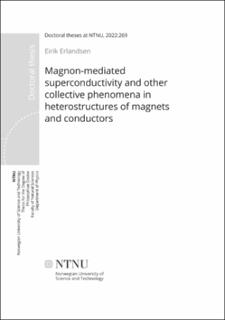| dc.contributor.advisor | Sudbø, Asle | |
| dc.contributor.advisor | Linder, Jacob W. | |
| dc.contributor.author | Erlandsen, Eirik | |
| dc.date.accessioned | 2022-09-23T07:12:24Z | |
| dc.date.available | 2022-09-23T07:12:24Z | |
| dc.date.issued | 2022 | |
| dc.identifier.isbn | 978-82-326-5444-4 | |
| dc.identifier.issn | 2703-8084 | |
| dc.identifier.uri | https://hdl.handle.net/11250/3020800 | |
| dc.description.abstract | Sammendrag:
Superledning fra magnetisme
Når ulike typer materialer kobles sammen, kan deres egenskaper bli påvirket av hverandre. Spesielt i nærheten av overflaten mellom to ulike materialer, kan nye ting skje. Denne avhandlingen bidrar til å, gjennom teoretiske beregninger, undersøke hvilke fysiske fenomener som kan finne sted når materialer med metalliske og magnetiske egenskaper kombineres.
Et, potensielt, veldig nyttig fysisk fenomen er superledning, som innebærer at et materiale er i stand til å lede elektrisitet uten at energi går tapt som varme. Superledning kan finne sted i vanlige materialer som aluminium, men krever vanligvis at materialene kjøles ned til temperaturer langt under romtemperatur. Ordentlig utnyttelse av det enorme potensialet superledere har til å redusere energitap kan derfor først oppnås dersom man klarer å finne eller konstruere et materiale som er superledende ved normale forhold. For å få til dette, kan et viktig steg på veien være å bedre forstå hvilke egenskaper ved et materiale som er avgjørende for at superledning skal kunne finne sted.
Hovedfokuset i denne avhandlinger er på om superledning kan oppstå i et metallisk materiale ved å koble det til ulike magnetiske materialer. Konklusjonen er at dette muligens kan være mulig for gunstige valg av materialer. Formålet med arbeidet er å bidra til en bedre forståelse for hvilken rolle magnetisme kan spille for at superledning skal oppstå. | en_US |
| dc.description.abstract | In many cases, magnetic materials, such as ferromagnets and antiferromagnets, and conductors, such as normal metals and superconductors, represent quite well-understood systems that condensed matter physicists are able to effectively model and describe. Rather than directly contributing to the understanding of such materials, or their more complicated and more mysterious relatives, this thesis is focused on the physics that arise when magnets and conductors are joined together in heterostructures. However, as such heterostructures involve itinerant electrons coupled to magnetism, they might, in addition to being interesting or useful in themselves, also be capable of shedding some light on the physics of interesting single-material systems such as materials featuring unconventional superconductivity.
The first four papers consider the possibility of inducing superconductivity in a conductor through spatial proximity to magnetic insulators. While the second paper is concerned with coupling of the conducting surface states of a topological insulator to both ferromagnetic and antiferromagnetic insulators, the three other articles consider normal metals proximitized by antiferromagnetic insulators. The articles focus on the importance of the magnetic structure at the interfaces between the different materials. If both the spin-up and spin-down sublattices of an antiferromagnet are exposed at an interface, the effective fermion-fermion interaction mediated by spin fluctuations will, under certain circumstances, be suppressed compared to the case where only one of the two antiferromagnetic sublattices couple to the itinerant electrons in the conductor.
In the fifth paper, we study indirect magnetic exchange interaction between two ferromagnets mediated by an unconventional superconductor. The sixth paper is concerned with the maximum spin-splitting field that spin-singlet superconductivity can survive. Finally, in the seventh paper, we return to the antiferromagnet/normal metal system in order to investigate whether an electron charge current, flowing parallel to the interface in the normal metal, can induce a magnon spin current in the antiferromagnet. | en_US |
| dc.language.iso | eng | en_US |
| dc.publisher | NTNU | en_US |
| dc.relation.ispartofseries | Doctoral theses at NTNU;2022:269 | |
| dc.relation.haspart | Paper 1: Erlandsen, Eirik; Kamra, Akashdeep; Brataas, Arne; Sudbø, Asle.
Enhancement of superconductivity mediated by antiferromagnetic squeezed magnons. Physical review B (PRB) 2019 ;Volum 100.(10)
https://doi.org/10.1103/PhysRevB.100.100503
©2019 American Physical Society | |
| dc.relation.haspart | Paper 2:
Erlandsen, Eirik; Brataas, Arne; Sudbø, Asle.
Magnon-mediated superconductivity on the surface of a topological insulator. Physical review B (PRB) 2020 ;Volum 101.
https://doi.org/10.1103/PhysRevB.101.094503
©2020 American Physical Society | |
| dc.relation.haspart | Paper 3:
Erlandsen, Eirik; Sudbø, Asle.
Schwinger boson study of superconductivity mediated by antiferromagnetic spin fluctuations. Physical review B (PRB) 2020 ;Volum 102.(21)
https://doi.org/10.1103/PhysRevB.102.214502
©2020 American Physical Society | |
| dc.relation.haspart | Paper 4:
Thingstad, Even; Erlandsen, Eirik; Sudbø, Asle.
Eliashberg study of superconductivity induced by interfacial coupling to antiferromagnets. Physical review B (PRB) 2021 ;Volum 104.(1)
https://doi.org/10.1103/PhysRevB.104.014508
©2021 American Physical Society | |
| dc.relation.haspart | Paper 5:
Ghanbari Birgani, Atousa; Erlandsen, Eirik; Linder, Jacob.
Effect of midgap states on the magnetic exchange interaction mediated by a d-wave superconductor. Physical review B (PRB) 2021 ;Volum 104.(5)
https://doi.org/10.1103/PhysRevB.104.054502
©2021 American Physical Society | |
| dc.relation.haspart | Paper 6:
Ghanbari Birgani, Atousa; Erlandsen, Eirik; Sudbø, Asle; Linder, Jacob.
Going beyond the Chandrasekhar-Clogston limit in a flatband superconductor. Physical review B (PRB) 2022 ;Volum 105.(6)
https://doi.org/10.1103/PhysRevB.105.L060501
©2022 American Physical Society | |
| dc.relation.haspart | Paper 7:
Erlandsen, Eirik; Sudbø, Asle.
Magnon drag in a metal-insulating antiferromagnet bilayer. Physical review B (PRB) 2022 ;Volum 105.(18)
https://doi.org/10.1103/PhysRevB.105.184434
©2022 American Physical Society | |
| dc.title | Magnon-mediated superconductivity and other collective phenomena in heterostructures of magnets and conductors | en_US |
| dc.type | Doctoral thesis | en_US |
| dc.subject.nsi | VDP::Mathematics and natural science: 400::Physics: 430 | en_US |
